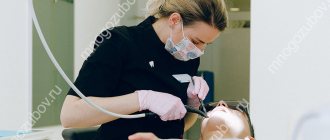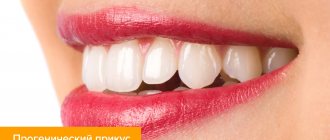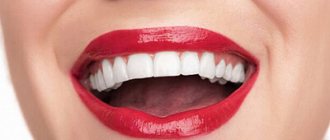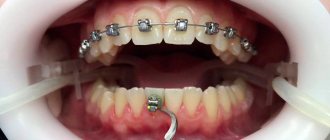All human teeth seem to be similar to each other. But the structure of the eye teeth, or fangs, as well as their appearance are very different from other species. For this reason, braces are often placed on fangs.
As for other teeth, each person has 4 types:
- front incisors - 2 pieces in one row of teeth;
- fangs - 1 in a row;
- premolars - 2 pieces;
- molars - 2 pieces.
So 4 dentitions make up 28 teeth; subsequently, in most people, 4 wisdom teeth are added to them.
What are each type of teeth?
Let's take a closer look:
- The incisors are the front teeth in the middle of the jaw. They only have one root. They have an external convex and internal, slightly concave surface, as well as small tubercles at the base. They are intended primarily for tearing food into separate pieces (biting off). Due to their sufficient weakness, they are practically not suitable for chewing.
- The canines follow in a row behind the incisors, located in the corners of the jaws. They are equipped with the longest root and crown, so they are quite strong.
- Premolars are located behind the canines. Their chewing surface is much wider and has 2 tubercles for chewing. Children do not have such teeth.
- Molars are the largest size. They are designed to grind food. There are three to five chewing tubercles on the surface.
Anomalies in the development of the dentition
Most often, if we consider all types of teeth, anomalies of an orthodontic nature occur in the canines. Many patients turn to specialists to correct the incorrect position of these teeth. Curvature of the fangs is observed in every third patient of orthodontists.
Types of curvature (dystopia) of fangs:
- fangs protruding from the jaws;
- hidden behind other teeth;
- very short or long;
- expanded;
- did not cut through completely.
The anomaly of the fangs “vampire smile” not only spoils the aesthetic side of the smile, but also interferes with the correct implementation of the function of eating. In this case, they seem to support the corners of the mouth. Braces can be a great solution to this problem.
Interesting moments that the patient described about the sensations on the aligners
The patient noted in the messenger that his tooth (fang) was moving and he was afraid to remove the aligner along with the fang! The movement of the canine as a result of removing crowding does occur, and as a result, tooth mobility can actually be felt. But since all dental movements during treatment with aligners are planned in advance, and the patient’s teeth are reliably protected in the aligners, all worries were removed.
As I told you earlier, once on a business trip in a restaurant, when he forgot the container and put the aligners next to him on a napkin, the children at the next table laughed that he had taken off his dentures
In fact, aligners can and should be stored in a special container while brushing your teeth or eating
Problems of treating crowded teeth with aligners
There were no problems at all with wearing the aligners. The only thing is that the activator came off once - this was after six months, but this was quickly eliminated and did not affect the course of treatment.
There was a case when a patient went on vacation and did not take his mouthguard retainer with him - his internal retainer came unstuck and the tooth moved back a little, “rotated” as orthodontists say. Now the problem is over.
Treatment options for canine dystopia
It is quite easy to determine canine dystopia. The complexity of its treatment depends on how advanced the disease is, the age of the patient and the nature of the anomaly.
Main methods of treatment:
- remove a wisdom tooth (when its growth is the cause of the anomaly);
- the use of braces (often you have to remove one of the teeth, usually a premolar, and then the canine is moved to the right place);
- installation of a prosthesis, or transformation of the first premolar into a canine (if it is missing in the row);
- reposition in more severe situations.
Note: The earlier treatment begins, the greater the likelihood that the patient will retain all teeth. For children under 12 years of age, removable plates are used for alignment, and teeth that are not fully formed are quickly aligned (in three to six months).
Teenagers aged 14-15 years old can benefit from braces very well without the need for surgical intervention, but in most cases such intervention is necessary for adults.
Removing "fours" or "sixes"
Sometimes, before installing braces, the patient needs to have the “fours” removed, that is, the first premolars - they have the smallest roots, so they are the easiest to pull out.
In addition, they bear less chewing load than, for example, molars, so their loss will not affect the patient’s health. The third candidate for removal is the fifth teeth. They are slightly larger than the “fours”, but the gaps left after their removal are practically unnoticeable when talking and smiling. Frontal teeth and canines undergo extraction much less frequently. “Sixes” are removed as a last resort, since they are quite difficult to remove, and the holes left behind them take a long time to heal. As for the seventh tooth, it is pulled out only if there is a healthy eighth tooth, in order to shift part of the load onto it. In addition, which teeth need to be extracted depends on the type of bite.
✔
In case of crossbites and distal bites, premolars, that is, either the fourth or fifth teeth, are most often removed.
✔
In case of an open bite associated with severe crowding and/or protrusion - protrusion of one of the jaws, removal of the upper and lower premolars, and at a very young age, also the canines, is indicated.
✔
As for the mesial bite, to correct it, the lower incisors are eliminated - in case of underdevelopment of the upper jaw - or “eights”.
Important!
A competent specialist, regardless of the indications, will always prefer to remove a diseased or decayed tooth rather than a healthy one.
Why can such teeth be crooked?
The canines are the last to erupt. They appear in a child at the age of 9-12, when all the other teeth have already erupted and taken a certain place. Sometimes there is simply no place for fangs in the dentition; it may already be occupied by another dental organ. Then the eye teeth can grow outside the dentition, dystopia is formed.
Another reason for the curvature of the fangs is their discrepancy with the size of the jaw. When a child inherits large teeth from one parent and a small jaw from another, canine anomalies occur quite often.
Anomalies can also be caused by untimely replacement of baby teeth with permanent ones.
How does alignment happen?
It usually takes 2 years to return the fang to its place with the help of braces.
It is important in such a situation to free up space for the fang by widening the jaw or getting rid of a poorly functional tooth.
If the second and fourth teeth are too close together, the quads are most often removed. When the fang only slightly protrudes from the dentition, removal is not required; in this case, it is enough to widen the jaw and at the same time move the dental organs to the right place.
Both regular metal braces and more aesthetic ones (lingual, ceramic, sapphire) can be used to straighten fangs.
It is important to start treatment as early as possible to avoid unpleasant consequences.
Let's smile together!
I want to tell you about such an important factor in treatment as emotions. If the attending physician, as a rule, always directs emotions in a positive direction, since correcting the patient’s bite is his profession, then for the patient, every moment of improvement in his current condition, or vice versa, every small anxious moment is a surge of emotions. That's right, because the patient begins a new life with a beautiful smile, and for him in this new life there is already a place for openness and positive impressions.
During treatment with aligners, as agreed, the patient very actively communicated with me using messengers.
Is it possible to fix fangs without braces?
Many patients refuse to use braces. Reasons for refusal, in addition to the aesthetic component of this treatment method, may be the following:
- high cost of design and procedures related to treatment;
- long duration of treatment;
- difficulty to predict the result;
- long period of rehabilitation.
Fangs can also be corrected using other methods. Which one is better suited in a particular situation depends on the complexity of the anomaly and the age of the patient.
Correcting an overbite for children is much easier than for adults. Therefore, there are more ways to achieve this goal.
Alternatives to correcting fangs with braces in children:
- using mouth guards at night;
- the use of soft plates that are removable are quite easy to maintain, but treatment with them will take longer;
- trainers - have a targeted effect on problem teeth, are easy to use, and quite effective (since they are made for a specific defect, which can be corrected much quickly).
For an adult who has serious bite problems, it is better to use braces. Only in cases where the pathology is minor can other treatment methods be used. Such as:
- the use of removable aligners - does not affect the appearance of the smile, they need to be used for 1.5-3 years;
- veneers - used for minor pathology affecting only the appearance, if necessary, quickly correct it; These are thin plates attached to the teeth, do not cause discomfort, are almost invisible, but do not solve the problem itself, improving only the appearance.
The doctor decides whether to use braces to treat the bite or use alternative methods. After a thorough examination and obtaining the necessary results, he applies one or another method.
Whatever structures are used by the patient for treatment, he needs to constantly visit a doctor who will advise and monitor the correct course of the treatment process.
My comment on this treatment:
I am satisfied with the result of the treatment and, probably, with the entire treatment process (even the slight anxiety and scrupulousness of the patient), it is nice to see in the end a satisfied, grateful and constantly laughing patient.
Correcting the position of fangs with braces
Placing the fangs in the right place and aligning them takes 1-2 years of treatment with braces. This procedure sometimes requires removing one tooth from a row or widening the jaw, thus freeing up the necessary space. For minor curvatures, these procedures do not have to be resorted to.
You can use different braces to straighten your fangs: metal, ceramic, lingual or sapphire. It is better to carry out this treatment in adolescence. This way, the result will be achieved much easier and faster.
Braces can be installed only on the fangs, if there is no curvature of other teeth. It will take several years of treatment to straighten the fangs in such a situation.
You can straighten protruding fangs, depending on how severe the pathology is and its characteristics, in different ways.
Let's consider the average treatment option:
- First you need to cure all organs of the oral cavity, get rid of caries, plaque and stone.
- Then they examine the oral cavity, make impressions, and take x-rays. With their help, the structure is made.
- In order to free up space, the jaw is expanded if necessary or some teeth are removed.
- Next, the braces are installed.
- After the result is achieved, the braces are removed and retainers are selected for the patient. To secure the result, he will need to wear them for some time.
Home | Pros of self-ligating braces
Benefits of Self-Ligating Braces for Correcting Teeth Crowding
Advantage of self-ligating braces #1
When using DAMON braces and their analogues, crowded teeth are quickly corrected, especially with high position of the canines. It is believed that DAMON braces most effectively and quickly straighten teeth in the initial stages of bite correction.
Photo No. 1. DAMON braces are installed on the upper jaw of a 12-year-old patient.
Photo No. 2. The same patient 3 months later.
Photo No. 3. DAMON3 braces are fixed on the upper jaw of a 14-year-old patient.
Photo No. 4. After 6 days, the position of the canine in the same patient improved significantly. Unscheduled visit, the bracket came off.
Advantage of self-ligating braces No. 2
When correcting severe crowding with the removal of premolars, the alignment of the canines occurs in the intervals from extraction without the application of additional load under the influence of weak forces.
Photo No. 5. Fixation of DAMON3 braces on the upper jaw of a 15-year-old patient.
Photo No. 6. View of teeth after 3 months of treatment with DAMON braces. It can be seen that the canine has moved towards the removed maxillary premolar.
Photo No. 7. After the removal of premolars, a 16-year-old patient was fixed with DAMON Q braces.
Photo No. 8. Scheduled appointment with the patient after 3 months of treatment with DAMONQ self-ligating braces. It can be seen that the canines have taken the place of the removed premolars.
Photo No. 9. DAMON3 braces are fixed on the upper jaw of a 30-year-old patient. A premolar in the upper jaw was previously removed.
Photo No. 10. The same patient after 3 months of treatment with DAMON3 braces. It can be seen that the canine has moved towards the removed premolar, completely occupying this space.
Advantage of using self-ligating braces No. 3.
Correction of the bite with self-ligating braces in the case of a distal bite ensures the correct displacement of the teeth of the upper jaw, while correcting the distal bite without removing the premolars. Treatment with self-ligating braces eliminates the need to use devices that are inconvenient for the patient to correct distal occlusion. This mainly applies to growing patients. Under the influence of self-ligating braces, their lower jaw moves forward. This speeds up and simplifies bite correction. Growing patients here should be considered adolescents aged 11 to 17 years with a distal malocclusion. In adult patients with slight distal occlusion, correcting the occlusion with self-ligating DAMON braces can also be very effective.
Photo No. 11. The patient is 15 years old, crowded teeth combined with distal occlusion. Before installing the braces system.
Photo No. 12. The same patient, after 3 months of correcting the bite with DAMON Q braces. In addition to correcting the crowding, correction of the distal bite is observed.
Photo No. 13. The patient is 12 years old. The photo was taken immediately after installing DAMON 3 braces.
Photo No. 14. The same patient after 2 months of orthodontic treatment with self-ligating braces. Correction of distal occlusion and elimination of crowding of teeth are visible.
Advantage of self-ligating braces No. 4.
When treating a malocclusion with self-ligating braces, the dentition expands, especially in the upper jaw. Jaw expansion with self-ligating braces occurs without the use of additional devices that are inconvenient for the patient. In this case, the doctor uses very weak forces. The passive self-ligation system in DAMON braces and similar ones reduces friction and allows you to effectively correct narrowing of the jaws.
Photo No. 15. The patient is 13 years old. Obvious narrowing of the upper jaw. Photo before fixing braces.
Photo No. 16. The same patient after 5 months of bite correction with DAMON Q braces. A significant expansion of the upper jaw is visible.
Advantage of self-ligating braces No. 5
Correcting a bite with self-ligating braces allows you to form the shape of the dentition that is characteristic of a given patient. Under the influence of pressure from the muscles of the cheeks, tongue, lips under the influence of soft arches in the bracket groove, an individual shape of the dentition is formed.
Photo No. 17,
Photo No. 18,
Photo No. 19 shows how the shape of the dental arches varies between patients. These patients use DAMON braces in the final stages of treatment.
Thus, simple ligature braces cannot compete with the effectiveness and convenience of treatment with self-ligating braces.
You can see the cost of self-ligating braces here.
Pros and cons of orthodontic construction
Braces have the following advantages:
- With their help, you can cope with almost any jaw anomaly, regardless of the stage of curvature.
- There are practically no contraindications to their use.
- Already in the first months of treatment, the result is noticeable.
- Suitable for both adults and children.
- The installation procedure takes place exclusively in a dental clinic. The patient himself does not need to take them off and put them on, since the design is non-removable.
- The latest developments in braces are almost invisible to others.
Disadvantages of designs:
- The need for more thorough oral hygiene. In addition to teeth, braces also need to be thoroughly cleaned to prevent diseases such as caries, periodontitis and gingivitis from developing. This procedure should be performed after every meal.
- Long-term wearing design.
- Aesthetic side. Not all braces look attractive. But there are many of them that are practically invisible on the teeth (ceramic, lingual).
- High price when compared with other correction systems.
Advantages and disadvantages of orthodontic systems
Installing braces on fangs has the following advantages:
- Even the most complex dentofacial curvatures can be cured;
- obtaining positive dynamics after several months of wearing the structure;
- Possibility of use by both children and adults;
- reliable fixation on the teeth (falling off at the most inopportune moment is excluded);
- the ability to use aesthetic devices that are practically invisible to others.
As for the disadvantages, it should be noted here:
- Difficulties in maintaining oral hygiene (cleaning out food debris from under braces is difficult and takes time);
- the need to wear the leveling structure for at least one year;
- change in the appearance of your smile for the worse during treatment;
- high cost of therapy.
Failure Cases
Correcting fangs with braces is a procedure that leads to excellent results. But some patients refuse such treatment.
Let's look at the reasons for this refusal:
- Long term treatment, during which you need to wear braces.
- The procedure is quite expensive.
- Difficulties in predicting the final result.
- Long recovery period after treatment.
The choice is always up to the patient, and canines can also be corrected in case of refusal of braces using mouthguards, trainers or soft plates. But these types of treatments can only help at a young age; they are not suitable for adults.
Only with slight protrusion of fangs in adults can they be corrected using mouthguards.
Mouthguards are worn at night. Soft plates are much easier to maintain compared to braces, but the duration of treatment with their help is quite longer. Trainers are convenient and act on the existing defect in a targeted manner.
For adults, lumineers and veneers can also be an alternative to braces. They are placed on the back of the teeth. But their effect will only improve the appearance, without curing the disease itself.
How to straighten teeth without braces
With age, bone and connective tissue become more rigid and more difficult to move in the desired direction. Therefore, in an adult, bite restoration has a number of features.
Traditional orthodontic treatment is braces, but for various reasons it is not suitable for everyone. These may be individual contraindications of the patient, special requirements for appearance and diction.
An alternative way to straighten teeth is to use aligners (aligners) - orthodontic structures made of safe medical plastic, the wearing of which is invisible to others.
Surgical correction of the bite is less commonly used - this method is indicated in the most difficult cases (severe open bite, traumatic violation of symmetry, hereditary defects).
In consultation with an orthodontist, you will choose the method by which teeth will be straightened, based on the clinical picture, recommendations, and cost of treatment.
A word from the dentists
Anna Ivanova, orthodontist:
From a medical point of view, the use of braces is primarily necessary to correct the bite and prevent the occurrence of diseases associated with this problem.
These designs are most effective in correcting jaw abnormalities. This is clearly noticeable when comparing the situation before and after treatment. In addition to a beautiful smile, they provide the patient with natural chewing function and speech. In addition, the use of braces has almost no contraindications.
Inna Mutasova, orthodontist:
Wearing braces should not embarrass an adult in any way, but crooked teeth and an incorrect bite are a sufficient reason for embarrassment. Don't miss the opportunity to have a perfect smile. Without braces, serious defects cannot be eliminated.
Installation of veneers
Veneers are porcelain or composite plates that replace the outer thin layer of a tooth.
Effectively correct dental discoloration, cover cracks or stains due to enamel hypoplasia. Veneers are an aesthetic solution and do not replace orthodontic treatment. Unlike veneers, braces move teeth. Treatment with braces ensures the formation of an aesthetically correct smile, restoration of the physiological bite and function of the dental system. The material is for informational purposes only and is presented for informational purposes. It does not replace consultation with an orthodontist and is not a guide to correcting dental anomalies.
Patient reviews
Alla, 30 years old
I agreed to install braces after the doctor said that if the bite is not corrected, I could subsequently lose all my teeth. The structures had to be worn for about two years. The result was truly a perfect smile. But after a while, the distances between the teeth became noticeable. It turned out that the dentist forgot to prescribe mouth guards. Now I wear them all the time, and my smile is gradually returning to normal.
Alexander, 41 years old
My son wore braces for almost 2 years. There were unpleasant sensations after installation and tightening. Could only eat liquid food. With the appearance of wisdom teeth, the teeth began to bunch up again. So, the effect of braces is there, but it is short-lived.
Olga, 26 years old
I had braces for over a year. It took me a long time to choose a clinic and a specialist who would install them for me. After installation, the unpleasant time of correction began. She devoted a huge amount of time to oral hygiene. I used all kinds of cleaning methods.
At the beginning of treatment, I experienced severe pain and was on painkillers. But now I’m just happy and very grateful to my doctor. The teeth are straight, the smile is almost perfect. The only thing is that I still wear mouth guards at night.
Operation stages
Surgery always involves risks for the body. The operation to correct the bite is performed under general anesthesia, which also increases risks for the body. To prevent adverse reactions and complications, before performing the operation, the body must be examined for contraindications.
Another stage of preparation is a mandatory examination of the correction area to determine the structural features of the skeleton, the condition of bone and soft tissue. The advantage of the dental clinic is the possibility of computer 3D modeling of the patient’s face, which will allow you to plan the course of the operation and see the result in advance.
General stages of orthopedic surgery for bite correction:
- administration of anesthesia;
- making incisions in the oral cavity to free access to the jaw bones;
- displacement of bones to the correct position;
- performing additional manipulations to eliminate the defect;
- fixation of jaw bones using screws and plates;
- application of a special splint to the surgical area.
Surgery can last from 1 to 6 hours. After the operation, the patient is in the clinic’s inpatient unit to monitor his condition.











